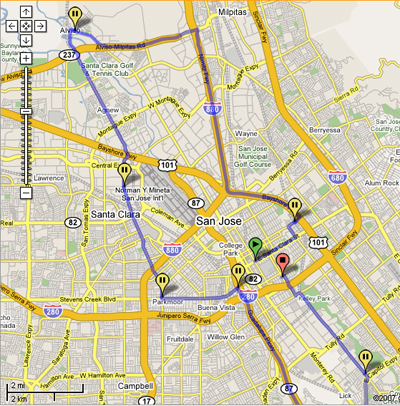Open source dialectic: the gift economy of artistic practice and the social systems created through open source artworks.
It was fitting that I met Sam Gould at a dinner which was provided only to the select few artists in residency at Montalvo. It was fitting because not only does Red76 have a distinctive history in the presentation of social projects integrated with the meal/restaurant framework, but also because of the "gift culture" of the art practice economy.
Due to the modernist notions of creativity being the fulcrum of artistic practice, the arts were opened up during the 50's and 60's to the academic practice of inclusion, rather than a defined vocational architecture for training artists. Artists were subsumed into a four year program which purported to allow free reign into creativity and bless the world with artistic voices. This model swamped the art market with art practitioners who were all attempting to sell the same thing: creativity/uniqueness. Of course, after fifty years of watching creativity unfold we now see that the open license to find uniqueness is as potent as a watered-down soup. There are only so many variations on themes before artists exhausted the possibilities. Through academia, armies of artists were being put through institutions which provided them with theory, but no means to elevate themselves beyond the romanticized homeless artist.
If I'm painting a dismal picture of the modernist view on the artist, it is because I find this view to be detrimental to both the public space community and the artist sphere. The artist community has strangled itself with an overabundance of practitioners within an economic sphere which isn't able to support itself. The public community shouldn't have to support the self-centeredness of the artistic community as structured in the modernist view.
But the interesting trade-off from the modernist influx of free-range artists is the gift culture within the economic system. "In gift cultures social status is determined not by what you control but by what you give away. Thus the Kwakiuti chieftain's potlatch party. Thus the multi- millionaire's elaborate and usually public acts of philanthropy, and thus the hacker's long hours of effort to produce high-quality open source code." (Raymond, 1998) Throughout the Pacific isles, the Trobriand Islanders shift between islands trading Kula rings to gain higher prestige. Entering into the trade culture requires a period of initial gift seasons taken to win the favor of lower spheres of exchange. Like the Trobriander's economy, the artists present offerings to the public and their clients in exchange for identification and increased reputation.
Upon entering the gallery world, the first common thread in the gallery model is the offerings provided by the artist or the gallery, at a drastic cut into the shares of any articles sold. These gifts are the tokens presented to the visitor in order to win prestige and status. This gift economy is a framework which social practice artists are able to use as a system for creating art as well as a framework to evaluate the systems of culture.
Ghosttown is a Red76 framework which allows the public to participate in open source community gift economies, while presenting a public forum for community issues. Specifically, let us look at Open Kitchen. The Open Kitchen project of Ghosttown is an open forum restaurant -- think potluck -- where the food is free as well as offering a location for people to express their memories connected to their food. The menu is determined by the public and the restaurant is a nonstationary space meant to initiate public space discussion. Obviously this refers to a gift economy and references [artists'] deeply rooted connection to this exchange. However, this project also initiates the public space on a specific level which interests me the most: it is meant as a launching pad for the public to recreate these activities. It is, in the engineering sense of the word, clearly open source.
Sam obviously loves food, especially food which interfaces itself with the public experience, e.g. taco trucks. For those who haven't experienced a taco truck, it is literally a meal on wheels. These mobile restaurants are able to offer cheap Mexican food because they do not have to pay the exorbitant lease costs for maintaining a stationary restaurant and are able to access their clients by visiting divergent locations from construction sites to high-tech parking lots. In a clear reference to the history of Alviso, there is a taco truck which has become stationary due to a loss of vehicular license.
This led Sam, Thomas and I to our discussion of the psychogeography of taco trucks in the San Jose area. As an exercise, we mapped out the best dives and known taco truck sites for noon on an average weekday. This map, linked through the image above, will take you to the hotspots of the public space as interfaced through this community. Any public participant could follow these directions and recreate the taco truck run. We invite you to interface with your public space -- create a forum at taco trucks to discuss why we have taco trucks and why they exist where they do.
- ‹ previous
- 395 of 798
- next ›

